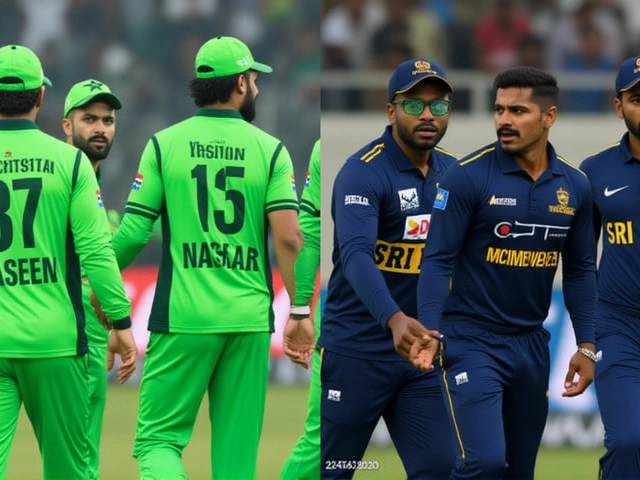On Thursday, November 27, 2025, the Pakistan vs Sri Lanka second ODI will ignite at the Rawalpindi Cricket Stadium, with Pakistan holding a slim 1-0 series lead after a nerve-wracking six-run win in the opener. The match, scheduled for 1:00 PM Pakistan Standard Time, isn’t just another game—it’s a turning point. If Pakistan wins, they seal the series. If Sri Lanka pulls off the upset, the decider in the third ODI becomes a high-stakes thriller. And with home advantage, momentum, and a dominant head-to-head record, Pakistan enters as heavy favorites—though cricket, as always, refuses to follow logic.
Rawalpindi’s Pitch and the Ghost of 214
The Rawalpindi Cricket Stadium has been a fortress for Pakistan this year, with the home side winning five of their last six matches here. But the real story lies in the numbers: the average second innings total in ODIs at this ground is just 214. That’s not a target—it’s a warning. In the first match, Sri Lanka chased 299 and fell just six runs short, a feat that defied the stadium’s history. How? Because Pakistan’s bowling, led by Haris Rauf (4 wickets), tightened like a vice in the final 15 overs. Sri Lanka’s Wanindu Hasaranga (59 off 52) and Kusal Mendis (Player of the Match despite the loss) fought brilliantly, but the middle order collapsed under pressure. That’s the pattern: Sri Lanka’s top order can spark, but they rarely sustain.Meanwhile, Pakistan’s chase in the first ODI was a masterclass in recovery. At 95 for 4 in the 24th over, collapse seemed inevitable. Enter Salman Ali Agha—unbeaten 105 off 87 balls, the kind of innings that turns series. His form is scorching: two half-centuries and a century in his last four ODIs. He’s not just scoring; he’s anchoring. And with Babar Azam and Fakhar Zaman yet to fire big in this series, the pressure is on them to convert starts. They’ve got the skill. Now they need the ruthlessness.
Who’s Really in Control? The Numbers Don’t Lie
The head-to-head stats are brutal for Sri Lanka: 94 wins for Pakistan in 158 ODIs, including four of the last five meetings. But stats don’t win matches—people do. And Sri Lanka’s new captain, Janith Liyanage, is showing grit. He smashed sixes like a man on a mission in the first match, while Pathum Nissanka and Charith Asalanka are quietly building into form. The question isn’t whether they can score—it’s whether they can survive the first 15 overs against Shaheen Shah Afridi and Naseem Shah on a pitch that offers early swing.Pakistan’s bowling depth is their secret weapon. Haris Rauf is lethal with the new ball. Mohammad Nawaz, who took seven wickets in the T20I Tri-Series and chipped in with 36 quick runs in the first ODI, is the X-factor. He’s the glue—part spinner, part finisher, part mental warrior. Sri Lanka’s attack, meanwhile, leans too heavily on Hasaranga. Dushmantha Chameera needs to be more consistent, and the spinners beyond Hasaranga? Underwhelming. If Pakistan’s lower order—Faheem Ashraf, Mohammad Nawaz, and even Salman Ali Agha—get going, Sri Lanka’s bowling will buckle.
Win Probabilities, Predictions, and the One Wild Card
Most models give Pakistan a 75% chance of victory, according to CricTracker. But here’s the twist: OCBScores claims a 100% win probability for Sri Lanka at odds of 2.50. That’s not a mistake—it’s a market signal. Someone, somewhere, knows something. Maybe it’s the weather. Maybe it’s a hidden injury. Maybe it’s the fact that Sri Lanka has won three of their last four ODIs against top-eight teams away from home. That’s not nothing.Score predictions vary wildly: CricketTimes expects Pakistan to post 280–300 if batting first; CricTracker thinks Sri Lanka can chase 260–290 if they bat second. The powerplay numbers are telling: Pakistan’s openers average 35–45, Sri Lanka’s 40–50. That suggests Sri Lanka will look to attack early, which could backfire against Shaheen’s swing or Naseem’s pace. But if they survive, Hasaranga and Asalanka could turn a shaky 60 for 2 into a 280+ total.
What’s at Stake? More Than Just a Series
This isn’t just about winning a trophy. For Pakistan, it’s about proving they’ve moved past inconsistency. Babar Azam’s return to the side is symbolic—he’s no longer captain, but his presence is leadership. If he scores a big one here, it signals a revival. For Sri Lanka, this is a lifeline. They’ve lost seven of their last ten ODIs against top teams. A win here doesn’t just save the series—it rebuilds belief. And for fans? It’s the kind of match that turns casual viewers into lifelong followers.The twist? Rawalpindi’s pitch has been drying out. If it cracks, spinners could dominate. Nawaz and Hasaranga will be the key. If the pitch stays true, it’s a batting paradise—and Pakistan’s depth should overwhelm. But if the ball swings early? That’s when Sri Lanka’s fragile top order could unravel.
What’s Next?
If Pakistan wins, they clinch the series with a game to spare. If Sri Lanka wins, the third ODI in Lahore becomes a do-or-die showdown. Either way, this match will shape how both teams enter the 2026 Asia Cup. Pakistan needs confidence. Sri Lanka needs proof they belong. And cricket? It’ll give us a story we won’t forget.Frequently Asked Questions
Why is Rawalpindi Cricket Stadium so important in this series?
Rawalpindi has hosted five of Pakistan’s last six home ODI wins, and the average second innings total here is just 214—making chases extremely difficult. Pakistan’s bowlers thrive on this pitch, especially with the new ball, while Sri Lanka’s top order has struggled to adapt to early swing in past matches here. The home crowd also adds pressure, making it harder for visitors to settle.
Who is the most dangerous player for Sri Lanka in this match?
Wanindu Hasaranga is Sri Lanka’s most dangerous player. He’s their top wicket-taker in the series so far and a proven match-winner under pressure. His leg-spin can break partnerships, and his aggressive batting in the death overs can turn a 240 total into a 280+ chase. If he gets a 40-ball 60 again, Sri Lanka’s chances jump dramatically.
Can Babar Azam still influence the match without being captain?
Absolutely. Babar is still Pakistan’s most technically sound batsman and a psychological anchor. Even without the armband, his presence stabilizes the top order. In the first ODI, he scored just 18, but his reputation forces bowlers to be cautious—opening doors for Salman Agha and Fakhar. A big score from him here would silence critics and shift momentum entirely.
Why do win probabilities differ so much between sources?
CricTracker’s 75% prediction for Pakistan is based on form, head-to-head stats, and home advantage. OCBScores’ 100% Sri Lanka win probability likely reflects betting market sentiment—where odds of 2.50 suggest value is perceived in an underdog win. It’s not a contradiction; it’s a reflection of different models: one uses data, the other uses market behavior. Both can be right in different ways.
What’s the biggest weakness in Pakistan’s lineup?
The top order’s inability to convert starts into big scores. Fakhar Zaman and Babar Azam both scored modestly in the first ODI despite getting good starts. If they fall early again, Pakistan could be 50 for 2 and forced to rely on Agha and Nawaz to rebuild—exposing their middle order to pressure. Consistency from the top three is the only thing standing between them and a nervy finish.
How could weather affect the match outcome?
A dry pitch with cracks could favor spinners like Mohammad Nawaz and Wanindu Hasaranga later in the game, making it harder for batters to accelerate. If rain interrupts play, a DLS target could favor the team batting second—likely Sri Lanka—if they’ve set a low total. But with no forecast of rain, the main concern is humidity affecting ball grip and swing, which could help Shaheen Afridi’s left-arm pace early on.







